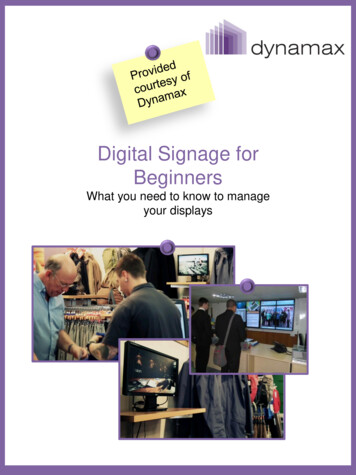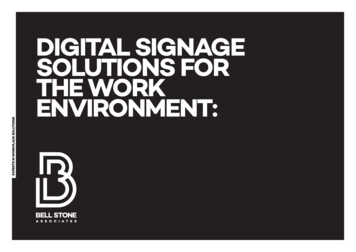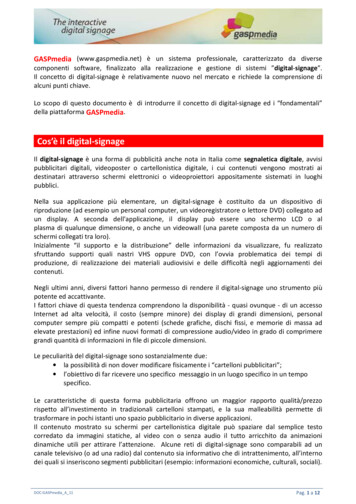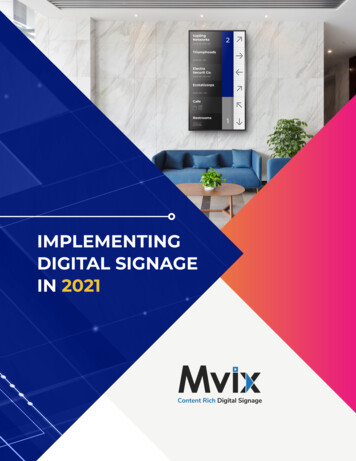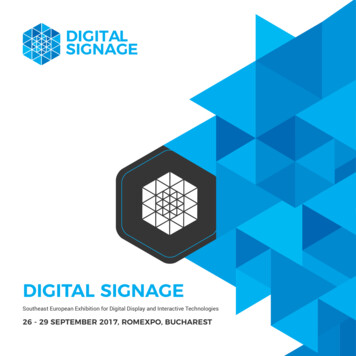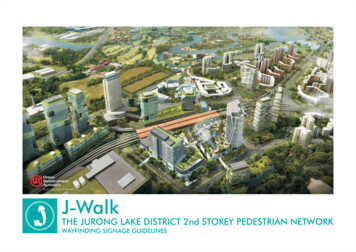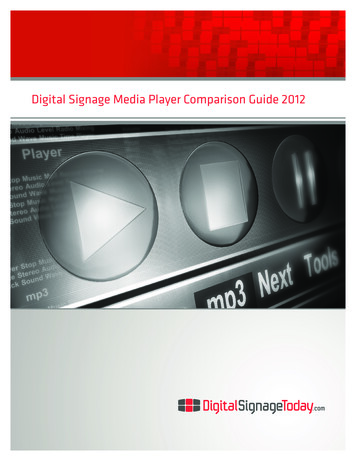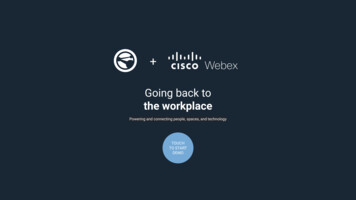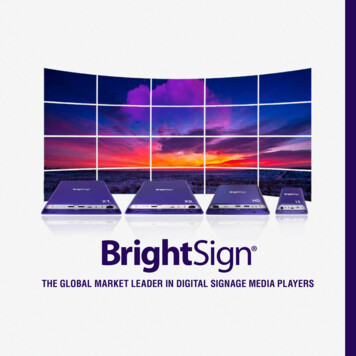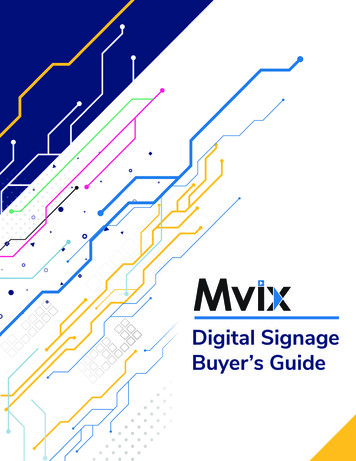
Transcription
Digital SignageBuyer’s Guide
Table of ContentsChapter 1 – Uses & Benefits of Digital SignageChapter 2 – Components of Digital SignageChapter 3 – Choosing a Digital Signage Player/HardwareChapter 4 – Selecting Digital Signage SoftwareChapter 5 – Content for Digital SignageChapter 6 – Qualities to Look for In a Digital Signage ProviderChapter 7 – Planning Your Digital Signage SystemChapter 8 – Screen Guide for Digital SignageChapter 9 – The Mvix AdvantageChapter 1Uses & Benefits of Digital SignageCommunication through digital signage is one of the most cutting-edge strategies formessaging in our modern advertising landscape. While digital signage can be applied toindustries of all kinds, it’s particularly useful for those that require attention-grabbing andflexible messaging:Corporate communicationHealthcareFood serviceEducationGovernmentIt’s a great way to provide clear, direct messaging, but it’s also a powerful way to improveadvertising ROI. A 2012 survey of American consumers by FedEx found that 76 percent ofshoppers will enter a store they’ve never visited based solely on its signage. What’s more, 68percent of these consumers believe that a store’s signage reflects the quality of its products orservices.The benefits are great, but implementing a digital signage strategy can be complicated. Thereare plenty of factors to consider, including the company’s needs, signage hardware, software,content management strategy, and the signage vendor.With that in mind, we’ve compiled a digital signage buying guide to walk customers throughthe purchasing process.www.mvixdigitalsignage.com
Chapter 2Chapter 3Every digital signage solution has three components:Don’t progress further in our digital signage buying guide until you understand yourhardware! In this chapter, we’ll review different types of players, storage options, inputdevices, and the different operating systems (OS) that run on each device.Components of Digital SignageHardware – Video screens, media players, and cablesChoosing a Digital Signage Player/HardwareSoftware – Applications, widgets, and the content management system(CMS) that brings it all togetherDigital Signage PlayersContent – Video, images, feeds, text, and any other messaging put ondisplay.External Players: These are small devices (about the size of a router) that come preloadedwith digital signage software. These devices tether to each display and connect to the CMSvia Wi-Fi, creating a powerful and flexible display solution.Each of these components will affect the capabilities of the signage solutionand the types of messages that can be displayed, but regardless of the chosenhardware and software, the setup and deployment follow a simple process.Digital signage players come in two styles:System on a Chip (SoC): SoC devices are similar to Amazon Fire Sticks or Google’sChromebit. These convenient tools turn nearly any television or digital screen into a digitalsignage tool and save users the hassle of connecting devices or cords. However, theytypically feature less flexibility in content storage and overall function.Storage OptionsIn terms of storage for your content, users have two options: The newer solid statedrive (SSD) and the older hard disk drive (HDD).1Digital signage screens are mounted and installed in locations thatmaximize visibility and viewer engagement.2Signage media players are connected to each screen via HDMI orDVI cable. Each of these players connects wirelessly to the internet,and each screen will require its own player.3Users log in to their CMS dashboard—accessible via the cloudfrom any web browser—to create custom content templates andschedules for each signage screen.4The media player pulls content from this CMS and stores it withinthe device until it’s ready for display.5The media player displays content on each screen as scheduled,with the user controlling content, scheduling, and layout remotelyvia CMS.6After publication, content can be removed, updated, or rescheduledvia CMS dashboard, creating a simple, user-friendly system fordigital messaging.www.mvixdigitalsignage.comThese days, SSD storage is the preferred option due to its speed, reliability, and smallersize. It’s more expensive than HDDs, but it’s important to understand that HDDs offerhigher levels of storage than SSDs.Therefore, content strategies that demand large amounts of video may be too muchfor SSD devices to handle. In these cases, HDD storage may be the better choice.
Input DevicesThe input devices used to connect digital screens to their media players also come in twostyles:DVI: DVI cables are larger, typically featuring a 24-pin connection point. These cables arethe older option of the two and support video only—meaning that an additional input willbe needed for users who need audio in their signage display.HDMI: HDMI cables feature connection points about the size of a USB contact. HDMIsupports both video and audio and is the newer of the two options—making it the idealchoice for most digital signage installations.Operating System OptionsUsers will also need to select which OS will house their software.Windows: Stable and familiar with plenty of flexibilityiOS: Popular and stable, though rare to see in a digital signage solutionAndroid: Free and user-friendly, though limited in functionChrome: Another free and easy-to-use option. However, its long-term performance isuntested in the digital signage marketLinux: Unmatched flexibility and customization but with a steep learning curveChapter 4Selecting Digital Signage SoftwareNext, users will need to select digital signage software for creating, controlling, andscheduling their content. Ask these questions before committing to a solution:Does it coordinate easily across every device in the organization?Can it manage other types of signage (mobile devices, touch screen kiosks, etc.) inaddition to mounted displays?Is it easy to use for content creation and layout organization?How well does it integrate with other data sources, such as Excel sheets,dashboards, or websites?Can it adapt for CAP alert messaging in times of crisis?Users also need to think about device security, how much support they’ll need, and whetherthey’ll want a one-time cost or an ongoing subscription for services. Before committingto digital signage software, users should identify their must-have features, content, andintegrations, and then compare this list against available ignage.com
Chapter 5Content for Digital SignageContent is the engine that powers digital signage and, naturally, is a significant topic for anydigital signage buying guide. Content is the way signage users connect with their viewers andthe way they achieve a stronger ROI with their digital signage.Develop a Content FoundationA content foundation is the underlying framework that will determine what content is createdand how it’s displayed. Here’s a brief outline of the process:Determine goals: What will the content achieve?Develop a strategy: Based on these goals, how will the content be assembled and whatapplications/widgets will best suit its needs?Assign a digital signage champion: Make sure the organization has a dedicated pointperson for digital signage decisions, support, and advocacy.Which Content Elements Should Be Included?Every content template used should feature several elements,regardless of industry:Text elements: Written material that provides vitalinformation. Balance this with other design elements andwhite space for maximum effect.Content design elements: Aspects of design that enhancethe written message; photos, charts, videos, and graphicalelements all fall into this category.Call to action: No matter what message the signage ispushing, there should be a clear and direct call to actionthat compels consumers to interact with the brand.Best Practices for Content CreationNot all content is created equal! Make sure all content posted on digital signage is craftedwith care:Visual appeal: Above all, content needs to look good. Get familiar with theelements of design, color schemes, and white space balance to make sure eachlayout is easy on the eyes.Quality control: If users misspell words or create unappealing layouts, it’lldamage the value of the messaging. A thorough quality control processfor all published materials is a must.
Chapter 6Qualities to Look for In a Digital Signage ProviderNext in our digital signage buying guide is a brief review of how to select the best digitalsignage provider. Users should take care to research their options thoroughly before committingto a vendor:Ask about experience: Are they known in the industry? What’s their track record? Lookfor customer testimonials or case studies that prove the quality of their service.Learn about pricing: Different providers offer different pricing packages based on theclient’s needs. Users should consider whether they need just one element of adigital signage solution (hardware, software, etc.) or a full turnkey solution that includesall the components.Understand their service options: Does the provider stand behind its products? Whatare its policies for support, ongoing maintenance, warranties, and customer service?Meeting industry-specific needs: Some providers specialize in healthcare digitalsignage, while others may specialize in retail options. Work with a provider whocan deliver exactly what’s needed and avoid making concessions for the sake ofconvenience.Chapter 7Planning Your Digital Signage SystemWith the above chapters of our digital signage buying guide established, it’s time to plan thedigital signage network itself. Use these as a guide:1Identify Goals: As before, think about the purpose of digital signagebefore installing it in the building. Some areas will feature higher foottraffic than others and will do well with fast-moving signage, whileother areas—such as waiting rooms—have a captive audience withtime to read longer messaging.2Determine the Scope: How many digital screens are needed? Is it asingle signage installment in a healthcare office? Or a company-wideshift to digital advertising across multiple locations?3Know the Budget: Be sure to factor in other issues aside from theinitial signage investment, such as the projected ROI from thesolution.4Know the Deadlines: Digital signage integrations don’t happenovernight, and the signage provider will need a timetable for installingand setting up equipment across locations.5Connect With the Stakeholders: Who are the primary decisionmakers in these processes? Is it the marketing department? The ITdepartment? Each stakeholder in the digital signage investment willneed to be consulted, so make sure everyone is kept in the loop.6Which Content Is Needed: Users can rely on built-in content deliveredthrough the CMS in a pinch, but companies will see the best ROI bycreating their own customized content layouts.7Learn the Provider’s Additional Services: A quality digital signageprovider will offer services beyond consultation and installation; thebest ones will help an organization completely optimize its digitalsignage investment across all fronts:Implementation Content design Maintenance and troubleshootingPersonalized usage training Signature care supportwww.mvixdigitalsignage.com
Chapter 8Screen Guide for Digital SignageThere are plenty of screen options for digital signage these days—toomany for our digital signage buying guide to cover! During the screenselection phase, keep these issues in mind to help make the decision:Are commercial-grade screens needed? Or can the companyget by with lower cost consumer-grade screens?Which resolution will best support the messaging? Mostcompanies can get by with basic HD screens, althoughcompanies that want to display highly-engaging visual contentmay enjoy the benefits of 4K screens.Of course, the optimal locations for each screen will need to bedetermined:Screen sizeScreen location in the buildingOptimal viewing angles along paths of travelDistance from viewersIf users are unsure about these decisions, the digital signage providerwill be able to help locate the optimal locations for signage impact.
Chapter 9The Mvix AdvantageOur clients continue to use our digital signage platform for four main reasons:1Our software is content-rich i.e. it has over 50 content apps that auto-update.This means our clients always have fresh content on their screens to keep theiraudiences engaged.2The content apps include simple ones like social media to custom ones likedashboards. This enables you to easily communicate with different audiences inthe same facility.3Our software is straightforward and easy to use. The user-friendly interface andsimple navigation make using digital signage easy.4Our solutions, which include software and hardware, are affordable so the ROI,whether monetary or qualitative, is a lot easier to achieve.These are the rewards you can expect in your digital signage deployment. Our teams willwork with you to find a solution that fits your budget, organization and culture:13 Years of Innovation & Experience: we’ve been improving our digital signagesolutions since 2005, releasing new content apps every quarter, so you can relyon us to be there consistently.Strong Community: we have a powerful community of customers, integrationpartners and technology partners to make sure our clients have a successfuldigital signage deployment.Experienced Consultants: our Solutions Consultants stay with us an average of 7years, so you know you are working with an experienced team to deploy digitalsignage that will engage your audience.Award-Winning Creative Team – with over 11 years of experience, you can workwith our design team like they are your own team to provide anything from stilland interactive designs for employee & customer communication, directories,videos walls and more.Project Management & Implementation: each client gets a dedicated projectmanager to direct their deployment for a successful, on-time launch, whetheryou’re working independently or with an integrator.Extensive Training & Knowledgebase : we provide custom, personalized trainingsas well as monthly webinars about software updates and new features. Our vastlibrary of FAQs, guides and video tutorials will help you get the most from oursolutions.Superior Support: our tech support team has a 94% CSAT. They can be reachedvia email, phone or web with coast-to-coast coverage hours. Our Signature Careprogram includes free device replacement and unlimited warranty among otherperks.With over 50,000 active screens being powered by our software, Mvix has what it takesto help your brand connect with people vixdigitalsignage.com
Chapter 3 - Choosing a Digital Signage Player/Hardware Chapter 4 - Selecting Digital Signage Software. Chapter 5 - Content for Digital Signage Chapter 6 - Qualities to Look for In a Digital Signage Provider. Chapter 7 - Planning Your Digital Signage System Chapter 8 - Screen Guide for Digital Signage. Chapter 9 - The Mvix Advantage
